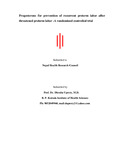Please use this identifier to cite or link to this item:
https://hdl.handle.net/20.500.14356/693Full metadata record
| DC Field | Value | Language |
|---|---|---|
| dc.contributor.author | Uprety, Prof. Dr. Dhruba | |
| dc.date.accessioned | 2012-12-28T05:24:40Z | |
| dc.date.accessioned | 2022-11-08T10:18:28Z | - |
| dc.date.available | 2012-12-28T05:24:40Z | |
| dc.date.available | 2022-11-08T10:18:28Z | - |
| dc.date.issued | 2012-12-27 | |
| dc.identifier.uri | http://103.69.126.140:8080/handle/20.500.14356/693 | - |
| dc.description | Introduction Preterm birth is the major cause of neonatal mortality and morbidity. In addition, prematurity is strongly associated with long-term developmental disabilities, accounting for 1 in 5 children with mental retardation, 1 in 3 children with vision impairment, and almost half of children with cerebral palsy. So, prevention of preterm birth is a public health priority. Methods A randomized controlled trial was undertaken in BP Koirala Institute of Health Sciences, where 60 patients were randomized into group 1 (n=29, weekly intramuscular Progesterone) and group 2 ( n=31,no treatment) after the arrest of preterm labor with tocolysis. Their latency period till delivery and recurrence of preterm labor and neonatal outcomes were compared. Results There was significant reduction in recurrence of preterm labor and increase in latency period in progesterone group. However neonatal outcomes were similar. Conclusion Progesterone is useful in reducing the recurrence of preterm labor in a patient who had preterm labor. | en_US |
| dc.language.iso | en_US | en_US |
| dc.subject | Progesterone | en_US |
| dc.subject | Tocolysis | en_US |
| dc.subject | Preterm labor | en_US |
| dc.title | Progesterone for prevention of recurrent preterm labor after threatened preterm labor -A randomized controlled trial | en_US |
| dc.type | Technical Report | en_US |
| Appears in Collections: | Post Graduate Grant (PG) Reports | |
Items in DSpace are protected by copyright, with all rights reserved, unless otherwise indicated.

